文章目录
1. Flume 概述
1.1 Flume简介
Flume是一种**可配置、高可用**的**数据采集**工具,主要用于采集来自各种流媒体的数据(Web服务器的日志数据等)并传输到集中式数据存储区域。
Flume 支持在日志系统中定制**各种数据发送方**,用于收集数据;并且可以对数据进行简单处理,将其写到可定制的各种数据接收方(如文本、HDFS、HBase等)。
Flume最主要的作用就是,实时**读取服务器本地磁盘的数据**,将数据写入到HDFS。
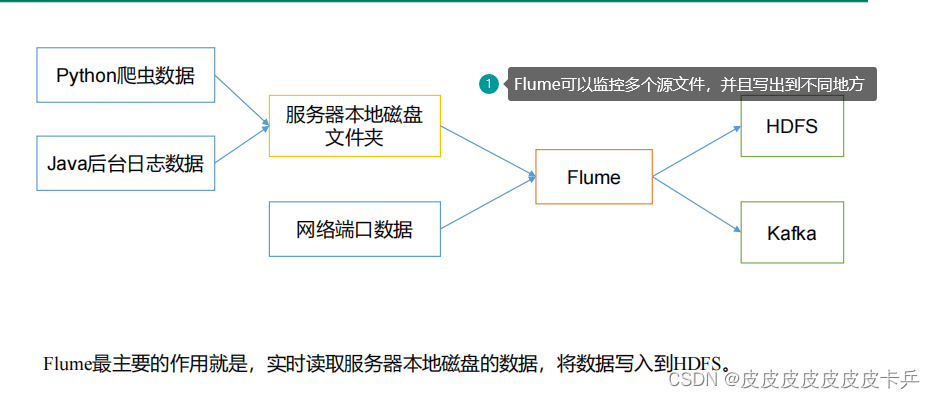
1.2 Flume的特点
(1)具有复杂的流动性。Flume允许用户构建多跳流,允许使用扇入流和扇出流、上下文路由和故障转移。
①多跳流:Flume中可以有多个agent【JVM进程】。事件(Event)需要通过多个agent才能到达最终目的地,成为多跳流。 ②扇入流:从一个源(Source)通过多个通道(Chanel)。 ③扇出流:多个源通过一个通道到达Sink。
(2)具有可靠性:Flume的源(Source)和接收器(Slink)封装在事务中,可以确保事件在数据流中从一个点 到另一个点的可靠性传递。
(3)可恢复性:事件(Event)存储在通道中,当Flume故障时,通道赋值恢复数据
1.3 Flume的基础架构
1.3.1 Agent简介
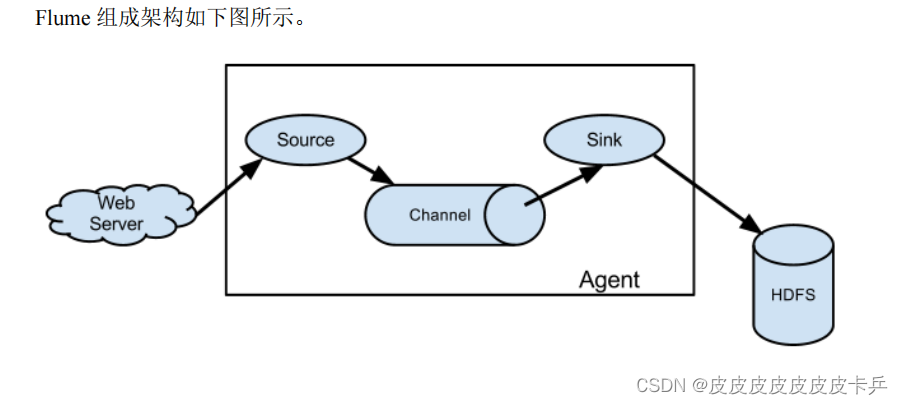
一个 JVM 进程,它以事件的形式将数据从源头送至目的。
Agent 主要有 3 个部分组成,Source、Channel、Sink。
Source简介
Source 是负责接收数据到 Flume Agent 的组件。Source 组件可以处理各种类型、各种格式的日志数据,包括 avro、thrift、exec、jms、spooling directory、netcat、taildir、sequence generator、syslog、httplegacy。-----》说白了就是就是数据来源
Slink简介
Sink 不断地轮询 Channel 中的事件且批量地移除它们,并将这些事件批量写入到存储或索引系统、或者被发送到另一个 Flume Agent。
Sink 组件目的地包括 hdfs、logger、avro、thrift、ipc、file、HBase、solr、自定义。-----》**数据最终写出的位置**
Channel简介:
Channel 是位于 Source 和 Sink 之间的缓冲区。因此,Channel 允许 Source 和 Sink 运作在不同的速率上。Channel 是线程安全的,可以同时处理几个 Source 的写入操作和几个Sink 的读取操作。------》中间的**缓冲区**
Flume 自带两种 Channel:Memory Channel 和 File Channel。
Memory Channel 是内存中的队列。Memory Channel 在**不需要关心数据**丢失的情景下适用。如果需要关心数据丢失,那么 Memory Channel 就不应该使用,因为程序死亡、机器宕机或者重启都会导致数据丢失。
File Channel 将所有**事件写到磁盘**。因此在程序关闭或机器宕机的情况下不会丢失数据。
1.3.2 Event简介
传输单元,Flume 数据传输的基本单元,以 Event 的形式将数据从源头送至目的地。
Event 由 Header 和 Body 两部分组成,Header 用来存放该 event 的一些属性,为 K-V 结构,Body 用来存放该条数据,形式为字节数组。
Flume 官网地址:http://flume.apache.org/
2. Flume安装配置
2.1 下载地址
(1)Flume 官网地址:http://flume.apache.org/
(2)文档查看地址:http://flume.apache.org/FlumeUserGuide.html
(3)下载地址:http://archive.apache.org/dist/flume/
2.2 安装部署
(1)将 apache-flume-1.9.0-bin.tar.gz 上传到 linux 的/opt/software 目录下
(2)解压 apache-flume-1.9.0-bin.tar.gz 到/opt/module/目录下
tar -zxf /opt/software/apacheflume-1.9.0-bin.tar.gz -C /opt/module/
(3)修改 apache-flume-1.9.0-bin 的名称为 flume
mv /opt/module/apache-flume-1.9.0-bin /opt/module/flume
(4)将 lib 文件夹下的 guava-11.0.2.jar 删除以兼容 Hadoop 3.1.3
rm /opt/module/flume/lib/guava-11.0.2.jar
3. Flume 使用案例
3.1 实时监控单个追加文件
- 需求: - 实时监控 Hive 日志,并上传到 HDFS 中(源文件为Hive日志,目标文件为HDFS)
- 分析:
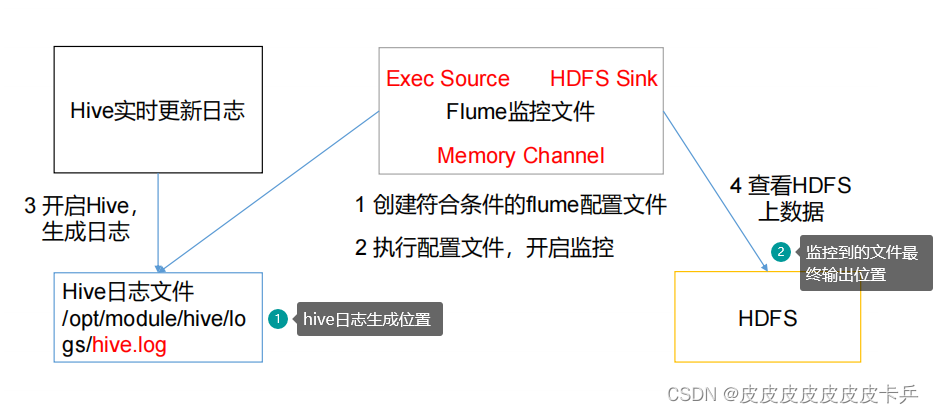
实战操作:
准备工作:启动mysql、Hadoop、Hive
创建flume-file-hdfs.conf 文件【其中配置源文件,目标文件,以及channel的相关信息-----》Flume收集工具就是通过读取此配置来实现实时监控】
#Name the components on this agent
a1.sources = r1
a1.sinks = k1
a1.channels = c1
#Describe/configure the source
a1.sources.r1.type = exec
a1.sources.r1.command = tail -F /opt/module/hive-3.1.2/logs /hive.log
#Describe the sink
a1.sinks.k1.type = hdfs
a1.sinks.k1.hdfs.path = hdfs://hadoop102:8020/flume/%Y%m%d/%H
#上传文件的前缀
a1.sinks.k1.hdfs.filePrefix = upload-
#是否按照时间滚动文件夹
a1.sinks.k1.hdfs.round = true
#多少时间单位创建一个新的文件夹
a1.sinks.k1.hdfs.roundValue =1
#重新定义时间单位
a1.sinks.k1.hdfs.roundUnit = hour
#是否使用本地时间戳
a1.sinks.k1.hdfs.useLocalTimeStamp = true
#积攒多少个 Event 才 flush 到 HDFS 一次
a1.sinks.k1.hdfs.batchSize =100
#设置文件类型,可支持压缩
a1.sinks.k1.hdfs.fileType = DataStream
#多久生成一个新的文件
a1.sinks.k1.hdfs.rollInterval =30
#设置每个文件的滚动大小大概是 128M
a1.sinks.k1.hdfs.rollSize =134217700
#文件的滚动与 Event 数量无关
a1.sinks.k1.hdfs.rollCount =0#Use a channel which buffers events in memory
a1.channels.c1.type = memory
a1.channels.c1.capacity =1000
a1.channels.c1.transactionCapacity =100#Bind the source and sink to the channel
a1.sources.r1.channels = c1
a1.sinks.k1.channel = c1
执行操作:
启动Flume监控:
bin/flume-ng agent -n a1 -c conf/-f job/flume-file-hdfs.conf
启动Hive,并且做出相关操作,使hivelog产生新的日志信息,以此作为数据源
//启动hive
bin/hive
//执行操作:
select * from table_name;
select count(*) from table_name;
Hive执行命令:
hive.log日志信息

HDFS存储的信息【source读取上述信息后,将日志读到HDFS】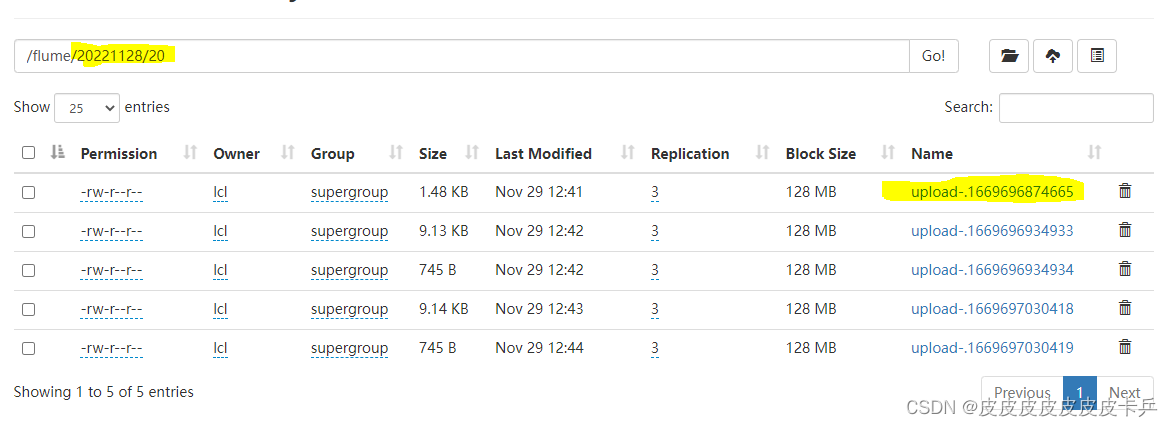
3.2 实时监控目录下多个新文件
案例需求:使用 Flume 监听整个目录的文件,并上传至 HDFS
需求分析:
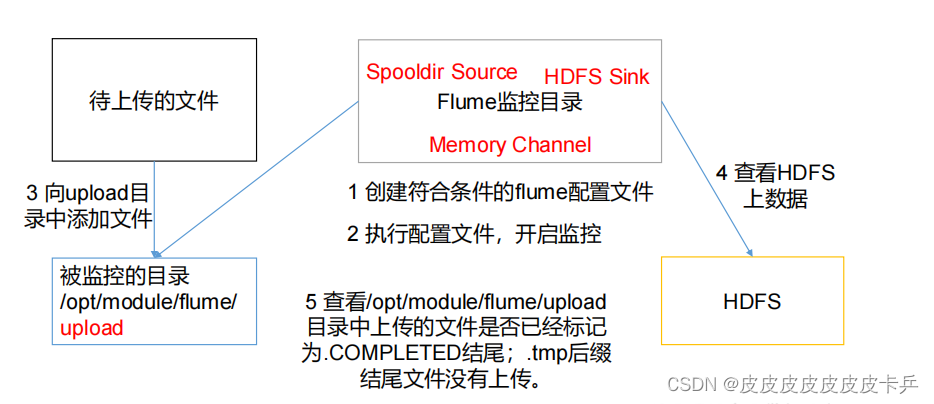
创建配置文件:
vim flume-dir-hdfs.conf
a3.sources = r3
a3.sinks = k3
a3.channels = c3
# Describe/configure the source
a3.sources.r3.type = spooldir
a3.sources.r3.spoolDir =/opt/module/flume-1.9.0/upload
a3.sources.r3.fileSuffix =.COMPLETED
a3.sources.r3.fileHeader =true
#忽略所有以.tmp 结尾的文件,不上传
a3.sources.r3.ignorePattern =([^]*\.tmp)
# Describe the sink
a3.sinks.k3.type = hdfs
a3.sinks.k3.hdfs.path = hdfs://hadoop102:8020/flume/upload/%Y%m%d/%H
#上传文件的前缀
a3.sinks.k3.hdfs.filePrefix = upload-
#是否按照时间滚动文件夹
a3.sinks.k3.hdfs.round =true
#多少时间单位创建一个新的文件夹
a3.sinks.k3.hdfs.roundValue =1
#重新定义时间单位
a3.sinks.k3.hdfs.roundUnit = hour
#是否使用本地时间戳
a3.sinks.k3.hdfs.useLocalTimeStamp =true
#积攒多少个 Event 才 flush 到 HDFS 一次
a3.sinks.k3.hdfs.batchSize =100
#设置文件类型,可支持压缩
a3.sinks.k3.hdfs.fileType =DataStream
#多久生成一个新的文件
a3.sinks.k3.hdfs.rollInterval =20
#设置每个文件的滚动大小大概是 128M
a3.sinks.k3.hdfs.rollSize =134217700
#文件的滚动与 Event 数量无关
a3.sinks.k3.hdfs.rollCount =0
# Use a channel which buffers events in memory
a3.channels.c3.type = memory
a3.channels.c3.capacity =1000
a3.channels.c3.transactionCapacity =100
# Bind the source and sink tothe channel
a3.sources.r3.channels = c3
a3.sinks.k3.channel = c3
配置信息解读: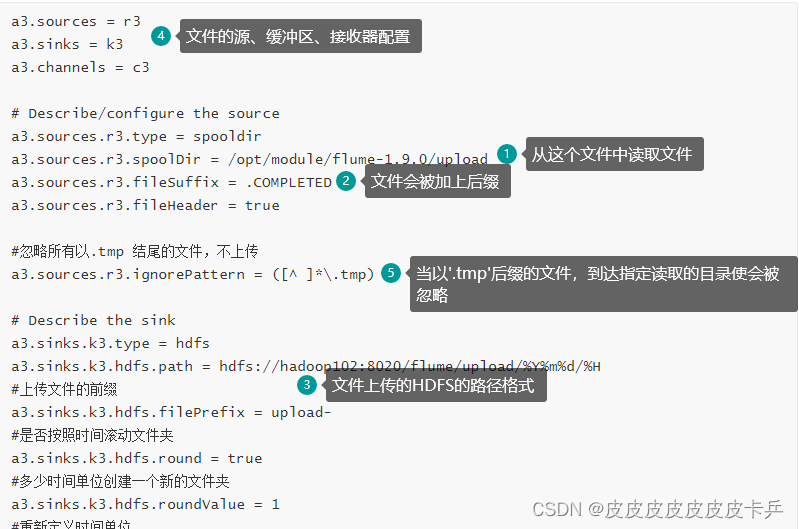
启动监控命令:
bin/flume-ng agent -n a3 -c conf/-f job/flume-dir-hdfs.conf

创建指定的源文件目录并且上传数据
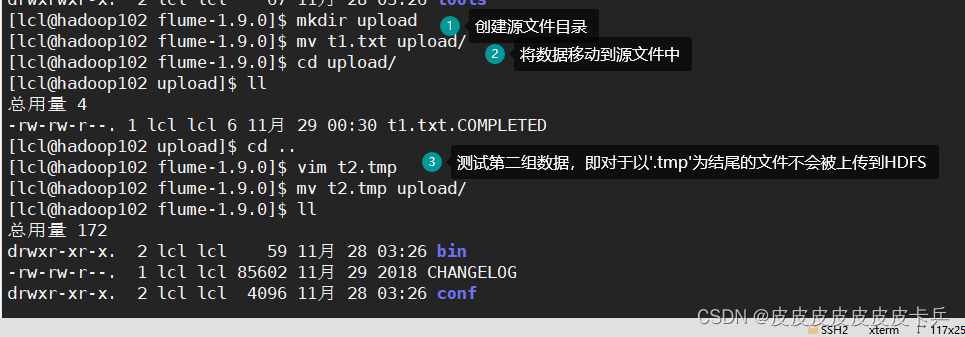
HDFS存储结果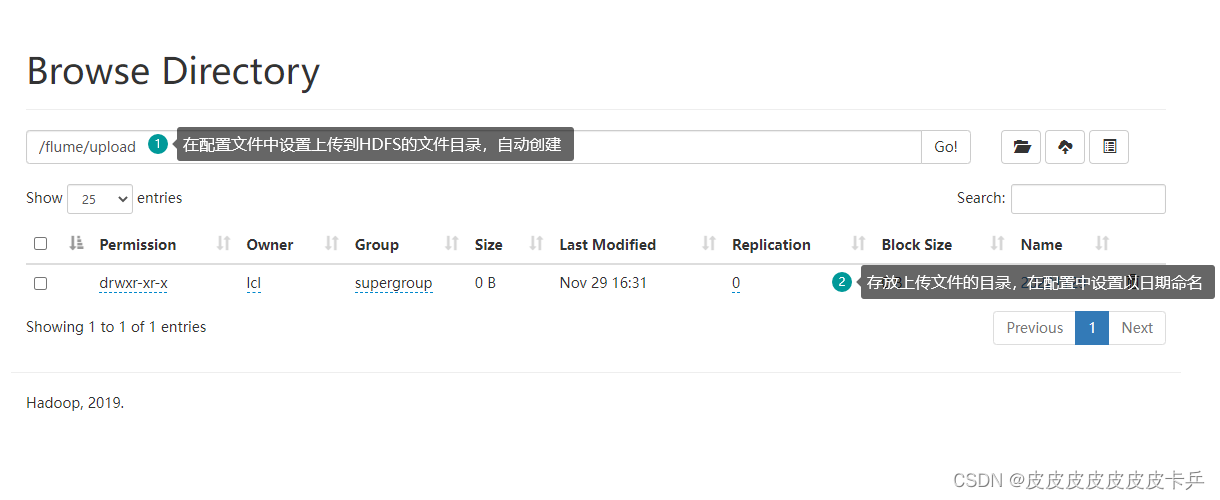
3.3 实时监控目录下的多个追加文件
Exec source 适用于监控一个实时追加的文件,不能实现断点续传;Spooldir Source适合用于同步新文件,但不适合对实时追加日志的文件进行监听并同步;而 Taildir Source适合用于监听多个实时追加的文件,并且能够实现断点续传。
- 案例需求: - 使用 Flume 监听整个目录的实时追加文件,并上传至 HDFS
需求分析:
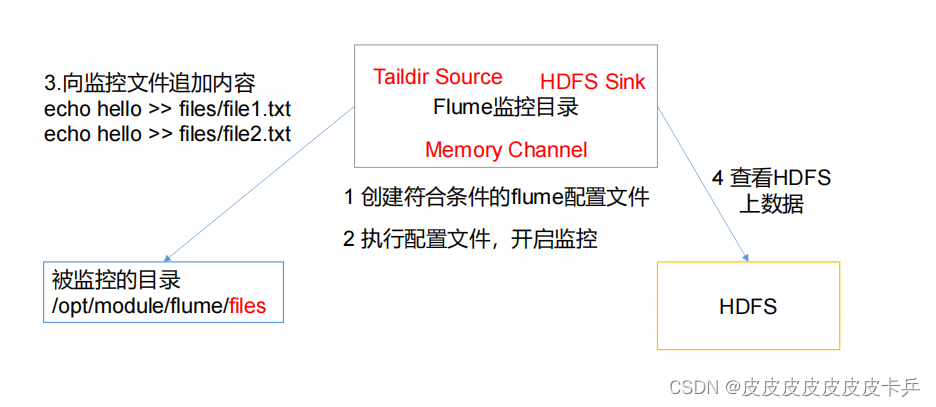
创建一个文件
vim flume-taildir-hdfs.conf
a3.sources = r3
a3.sinks = k3
a3.channels = c3
# Describe/configure the source
a3.sources.r3.type =TAILDIR
a3.sources.r3.positionFile =/opt/module/flume-1.9.0/tail_dir.json
a3.sources.r3.filegroups = f1 f2
a3.sources.r3.filegroups.f1 =/opt/module/flume-1.9.0/files/.*file.*
a3.sources.r3.filegroups.f2 =/opt/module/flume-1.9.0/files2/.*log.*
# Describe the sink
a3.sinks.k3.type = hdfs
a3.sinks.k3.hdfs.path = hdfs://hadoop102:8020/flume/upload2/%Y%m%d/%H
#上传文件的前缀
a3.sinks.k3.hdfs.filePrefix = upload-
#是否按照时间滚动文件夹
a3.sinks.k3.hdfs.round =true
#多少时间单位创建一个新的文件夹
a3.sinks.k3.hdfs.roundValue =1
#重新定义时间单位
a3.sinks.k3.hdfs.roundUnit = hour
#是否使用本地时间戳
a3.sinks.k3.hdfs.useLocalTimeStamp =true
#积攒多少个 Event 才 flush 到 HDFS 一次
a3.sinks.k3.hdfs.batchSize =100
#设置文件类型,可支持压缩
a3.sinks.k3.hdfs.fileType =DataStream
#多久生成一个新的文件
a3.sinks.k3.hdfs.rollInterval =20
#设置每个文件的滚动大小大概是 128M
a3.sinks.k3.hdfs.rollSize =134217700
#文件的滚动与 Event 数量无关
a3.sinks.k3.hdfs.rollCount =0
# Use a channel which buffers events in memory
a3.channels.c3.type = memory
a3.channels.c3.capacity =1000
a3.channels.c3.transactionCapacity =100
# Bind the source and sink tothe channel
a3.sources.r3.channels = c3
a3.sinks.k3.channel = c3
启动监控文件夹命令
[atguigu@hadoop102 flume]$ bin/flume-ng agent -n a3 -c conf/ -f job/flume-taildir-hdfs.conf
向 files 文件夹中追加内容
HDFS收到的存储内容
file目录的存储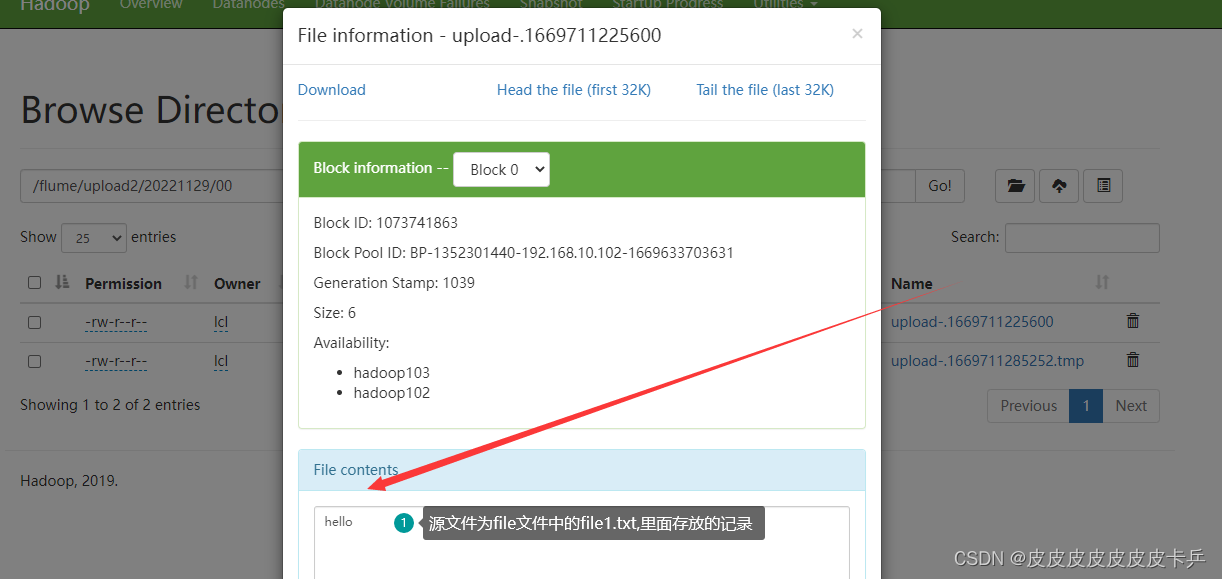
log目录的存储内容

版权归原作者 皮皮皮皮皮皮皮卡乒 所有, 如有侵权,请联系我们删除。